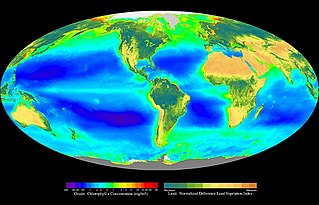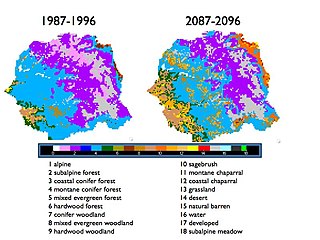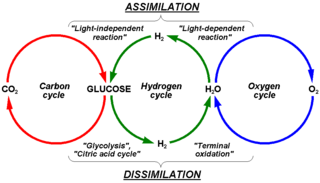
Photosynthesis is a biological process used by many cellular organisms to convert light energy into chemical energy, which is stored in organic compounds that can later be metabolized through cellular respiration to fuel the organism's activities. The term usually refers to oxygenic photosynthesis, where oxygen is produced as a byproduct, and some of the chemical energy produced is stored in carbohydrate molecules such as sugars, starch and cellulose, which are synthesized from endergonic reaction of carbon dioxide with water. Most plants, algae and cyanobacteria perform photosynthesis; such organisms are called photoautotrophs. Photosynthesis is largely responsible for producing and maintaining the oxygen content of the Earth's atmosphere, and supplies most of the biological energy necessary for complex life on Earth.

In botany, a stoma, also called a stomate, is a pore found in the epidermis of leaves, stems, and other organs, that controls the rate of gas exchange. The pore is bordered by a pair of specialized parenchyma cells known as guard cells that regulate the size of the stomatal opening.

In ecology, primary production is the synthesis of organic compounds from atmospheric or aqueous carbon dioxide. It principally occurs through the process of photosynthesis, which uses light as its source of energy, but it also occurs through chemosynthesis, which uses the oxidation or reduction of inorganic chemical compounds as its source of energy. Almost all life on Earth relies directly or indirectly on primary production. The organisms responsible for primary production are known as primary producers or autotrophs, and form the base of the food chain. In terrestrial ecoregions, these are mainly plants, while in aquatic ecoregions algae predominate in this role. Ecologists distinguish primary production as either net or gross, the former accounting for losses to processes such as cellular respiration, the latter not.
Frederick Frost Blackman FRS was a British plant physiologist.

John Lennox Monteith DSc, FRS was a British scientist who pioneered the application of physics to biology. He was an authority in the related fields of water management for agricultural production, soil physics, micrometeorology, transpiration, and the influence of the natural environment on field crops, horticultural crops, forestry, and animal production.
Howard Griffiths is a physiological ecologist. He is Professor of Plant Ecology in the Department of Plant Sciences at the University of Cambridge, and a Fellow of Clare College, Cambridge. He formerly worked for the University of Dundee in the Department of Biological Sciences. He applies molecular biology techniques and physiology to investigate the regulation of photosynthesis and plant water-use efficiency.

Soil respiration refers to the production of carbon dioxide when soil organisms respire. This includes respiration of plant roots, the rhizosphere, microbes and fauna.

Transpiration is the process of water movement through a plant and its evaporation from aerial parts, such as leaves, stems and flowers. Water is necessary for plants but only a small amount of water taken up by the roots is used for growth and metabolism. The remaining 97–99.5% is lost by transpiration and guttation. Leaf surfaces are dotted with pores called stomata, and in most plants they are more numerous on the undersides of the foliage. The stomata are bordered by guard cells and their stomatal accessory cells that open and close the pore. Transpiration occurs through the stomatal apertures, and can be thought of as a necessary "cost" associated with the opening of the stomata to allow the diffusion of carbon dioxide gas from the air for photosynthesis. Transpiration also cools plants, changes osmotic pressure of cells, and enables mass flow of mineral nutrients and water from roots to shoots. Two major factors influence the rate of water flow from the soil to the roots: the hydraulic conductivity of the soil and the magnitude of the pressure gradient through the soil. Both of these factors influence the rate of bulk flow of water moving from the roots to the stomatal pores in the leaves via the xylem.

A Dynamic Global Vegetation Model (DGVM) is a computer program that simulates shifts in potential vegetation and its associated biogeochemical and hydrological cycles as a response to shifts in climate. DGVMs use time series of climate data and, given constraints of latitude, topography, and soil characteristics, simulate monthly or daily dynamics of ecosystem processes. DGVMs are used most often to simulate the effects of future climate change on natural vegetation and its carbon and water cycles.

Photosynthesis systems are electronic scientific instruments designed for non-destructive measurement of photosynthetic rates in the field. Photosynthesis systems are commonly used in agronomic and environmental research, as well as studies of the global carbon cycle.

David Alan Walker was a British scientist and professor of photosynthesis in the Department of Animal and Plant Sciences (APS) at the University of Sheffield. He authored over 200 scientific publications including several books during his lifetime.

The carbon cycle is an essential part of life on Earth. About half the dry weight of most living organisms is carbon. It plays an important role in the structure, biochemistry, and nutrition of all living cells. Living biomass holds about 550 gigatons of carbon, most of which is made of terrestrial plants (wood), while some 1,200 gigatons of carbon are stored in the terrestrial biosphere as dead biomass.
John Albert Raven FRS FRSE is a British botanist, and emeritus professor at University of Dundee and the University of Technology Sydney. His primary research interests lie in the ecophysiology and biochemistry of marine and terrestrial primary producers such as plants and algae.

Govindjee is an Indian-American scientist and educator. He is Professor Emeritus of Biochemistry, Biophysics and Plant Biology at the University of Illinois at Urbana-Champaign, where he taught from 1961 until 1999. As Professor Emeritus since 1999, Govindjee has continued to be active in the field of photosynthesis through teaching and publishing. He is recognized internationally as a leading expert on photosynthesis.

David John Beerling is the Director of the Leverhulme Centre for Climate change mitigation and Sorby Professor of Natural Sciences in the Department of Animal and Plant Sciences (APS) at the University of Sheffield, UK. He is also Editor-in-Chief of the Royal Society journal Biology Letters.
Thomas D. Sharkey is a plant biochemist who studies gas exchange between plants and the atmosphere. His research has covered (1) carbon metabolism of photosynthesis from carbon dioxide uptake to carbon export from the Calvin-Benson Cycle, (2) isoprene emission from plants, and (3) abiotic stress tolerance. Four guiding questions are: (1) how leaf photosynthesis affects plant yield, (2) does some carbon fixation follow an oxidative pathway that reduces sugar output but stabilizes photosynthesis, (3) why plants make isoprene, and (4) how plants cope with high temperature.

Yadvinder Singh Malhi is professor of Ecosystem Science at the University of Oxford and a Jackson Senior Research Fellow at Oriel College, Oxford.

Reinhart Jan Maria Ceulemans is an emeritus professor of Ecology and previous director of the Research Center of Excellence PLECO of the University of Antwerp. He has been vice-dean of the Faculty of Sciences at the University of Antwerp, and was a visiting professor at the University of Washington, Seattle, USA (1987-1988), at the Université Paris-Sud XI, Orsay and at the University of Ghent. He officially retired in October 2019 and is now a visiting professor at the University of Antwerp (Belgium), a researcher at CzechGlobe Academy of Sciences in Brno and an international consultant to the Slovenian Forestry Institute.
Beverly Law is professor emeritus at Oregon State University known for her research on forest ecosystems, especially with respect to carbon cycling, fire, and how human actions impact future climate.
Mariah Suzanne Carbone is an American geophysicist who is a professor of Geosciences at the Center for ecosystem science and society, Northern Arizona University. She studies terrestrial ecosystems and how they respond to environmental change.














